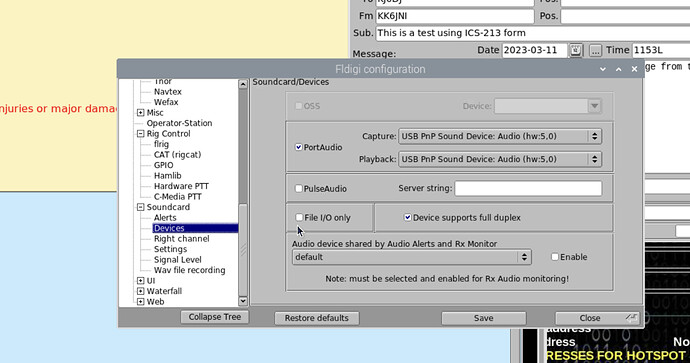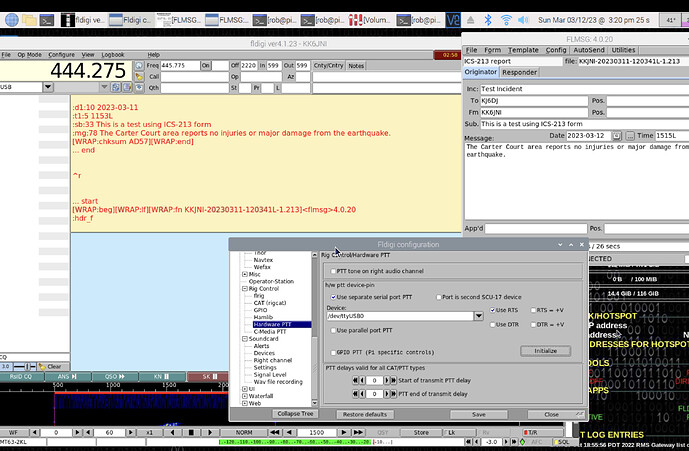Today I set up a Digirig Mobile v1.9 interface on my Raspberry pi 4 to use Fldigi and Flmsg with a Baofeng 5r5 and the Baofeng cable for Digirig radios.
[Baofeng cables kit for Digirig Mobile – digirig]
My local ham club was holding a Fldigi exercise and I was receiving MT63-2KL messages correctly with Fldigi, but others were not able to receive my transmissions unless I pushed the PTT button on the radio simultaneously with initiating the Auto Send transmission from Flmsg to Fldigi. Is this normal behavior with the Digirig?
With my setup, I was under the impression that the PTT would be triggered automatically through the cable connection to the radio without my physically pushing the PTT on the radio. Correct?
Here is a screenshot of the Soundcard/Devices configuration in Fldigi:
Is my Fldigi configuration incorrect? Or perhaps I need to change one of the settings on the radio?
Thanks for your consideration…
Rob KK6JNI
1 Like
I think you’ll also need to click on the Hardware PTT menu under Rig Control (just above the soundcard settings in the config menu you have pictured. Activate RTS, verify your correct com port, possibly activate “use separate serial port PTT”, and click initialize. I haven’t used a digirig with a baofeng yet, but those are the settings I have made work with other simpler radios.
1 Like
One more thing: in windows go to your control panel (search for it in the task bar)
Hardware & Sound | Sound
In Playback tab of the sound window select your PnP device (the digirig) and click properties.
- Levels tab: tune everything to zero db and unmute the microphone. If db isnt displayed, right click on the volume icon
-Enhancements tab: disable all enhancements
-Advanced tab: CD quality
-Apply, and OK
Return to Sound window, select recording tab. Select PnP device and click properties.
- Custom tab: unselect AGC. AGC is your enemy.
-Levels tab: zero db.
-Advanced tab: CD quality
-Apply and OK.
1 Like
Thanks for the reply. I made the changes you suggest, shown in the screenshot below:
What happens is when I click the AutoSend in the FLMSG program (using the ICS-213 form), the transmit begins on the radio connected to the Digirig, for about 2 minutes, and then drops. During the transmission, the second radio monitoring the channel is silent. I should be hearing noise, correct?
At about the two minute mark I start to see the message typed into the yellow box of FLDIGI, but very slowly (even more slowly than my touch-typing  .) It’s as if the baud rate has gotten slowed down. It seems like the yellow-box message is happening after the transmission has completed. The message finishes at about the 8 minute mark, then about a minute later, the red transmit timer goes off.
.) It’s as if the baud rate has gotten slowed down. It seems like the yellow-box message is happening after the transmission has completed. The message finishes at about the 8 minute mark, then about a minute later, the red transmit timer goes off.
Also, I don’t think that your second message applies to my configuration, since I am running Fldigi and Flmsg on a Raspberry Pi 4 under Linux.
1 Like
Oh. Me stupid. I forgot you wrote you’re on a pi. All those levels are managed through alsamixer on the pi. I just learned how to do that on the pi, and posted it here if you need it: Auto Gain Control in Linux?
I think I understand what youre describing about the behavior of the baofeng. Yes, if one radio is transmitting correctly, you should hear noise on the other. At the risk of overexplaining, here are some things I would check:
- Make sure the CTCSS codes are turned off on both radios. If you have non-compatible CTCSS codes, you may not hear the transmission from the second radio even if the first radio is transmitting properly. Of course also double check the simple things like frequency, wide/narrow band, that the antenna is screwed onto the radio, connections to the digirig, and make sure offset is turned off for simplex use.
- Check the time out timer in the settings. If you have TOT set for 120 seconds, the transmission will stop after 2 minutes.
- Feel the case of the transmitting radio. If it is too hot to comfortably touch after 2 minutes of transmission, you may be exceeding the duty cycle of that particular radio, causing the transmitting radio to malfunction in unpredictable ways. This could be remedied by upgrading equipment, selecting a faster digital mode, or transmitting fewer characters (send the information directly from fldigi without all the extra characters transmitted by an flmsg form).
1 Like
Continuing our convo from the other thread, I have made a baofeng work with fldigi using other brands of cables (utilizing VOX), so I know the radio is capable of digital modes transmission. But, the limitations of that radio were a constant struggle. If you choose to stick with the baofeng, I recommend turning off the battery saver in the baofeng settings menu (you need the receiver on and listening 100% of the time), and activating a half second pre-signal tone in Fldigi under Configure | IDs | RsID. You might opt to set the radio to transmit at lower power too, to keep the radio from heating up.
This article indicates that Digirig PTT control over the baofeng is possible, I just havent personally tried it yet: VHF/UHF Digital Modes with budget HTs – digirig
For HT transmission with fldigi I just picked up an icom IC-V80 sport, and the proper Digirig cable. It’s working fine for FSQ, including photo transmission with that mode. The price of an IC-V80 on ebay is comparable to the higher wattage baofeng HTs.
1 Like
I use the Digirig for PTT control over a Baofeng HT regularly. Digirig’s ability to do PTT-over-Serial with HTs is not usually questioned.
1 Like
I am working with DigiRig / Baofeng H6 / GPredict to play on satellites.
I can’t figure out how to get it to work. GPredict uses HAMLIB and Baofeng doesn’t show up as a supported radio.
Does anyone have any tips on A. How to even get the rig working with any piece of softare - I have FLRig and others. B. Any ideas on getting it to work with HAMLib?
Maybe this discussion needs its own thread, since RPI4 is not involved.
New thread:
73 Constrainted

